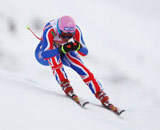 With thousands of people heading off to winter resorts, combined with the shocking news about Michael Schumacher's skiing accident, we thought it was appropriate for our resident writer (and Doctor) to outline a few basic precautions for those of you about to take to the slopes. Whether you are a beginner, intermediary or even an advanced skiier who's been lucky to avoid a skiing injury so far, then read on to learn about three most common skiing injuries and how to prevent them.
With thousands of people heading off to winter resorts, combined with the shocking news about Michael Schumacher's skiing accident, we thought it was appropriate for our resident writer (and Doctor) to outline a few basic precautions for those of you about to take to the slopes. Whether you are a beginner, intermediary or even an advanced skiier who's been lucky to avoid a skiing injury so far, then read on to learn about three most common skiing injuries and how to prevent them.
Thumb and Hand Injuries
The most common thumb or hand injury is caused during a fall, when the skier or snowboarder either fails to let go of the ski pole or throws out a hand to stop them from hitting the snow. Incorrect falling technique can result in a torn UCL ligament in the thumb, or a dislocated thumb or hand. If you hurt your thumb during a fall, you might need to see a hand surgeon to determine the extent of the damage. A serious thumb injury might require surgery.
In order to avoid thumb and hand injuries, practice the correct falling technique. In all probability, you are going to fall while skiing, no matter how good you might be or how easy the slope might seem. Do not try to break the fall with your hand. Release the ski poles as soon as the fall becomes imminent. Use handle-less poles for easy releasing.
Knee Injuries
Almost half of all skiing injuries are knee injuries, and are caused when angular loads are placed on the knee joint during a fall. Most of these injuries occur in the snow plow position, when the skiers widen their stance or cross their skis during falls, rotating their feet inwards and placing excessive twisting forces on the knees. This leads to a partial or complete tear of the MCL ligament in the knee. A splint and rest might be required to ease the pain and swelling before one can think of wearing the skis again. More serious knee injuries require surgery.
Knee injuries can be prevented through training and conditioning. If you haven’t skied in years, make sure you are in proper shape before you hit the slopes. Start working our 4–6 weeks prior to your skiing expedition and strengthen your quad muscles. One of the most important factors in avoiding knee injuries is to have proper binding and release settings on your equipment. Get your skies checked from a skiing shop for proper locking and unlocking before you wear them on the slopes. Too tight or too loose binding mechanisms increase the risk of knee injuries during falls. If you are taking kids along, make sure that their shoes aren't loose.
Head injuries
Skiing involves speeds ranging up to 35 mph on steeper slopes. A collision with another skier or a stationary object can spell disaster. Head injury is the severest form of skiing injury, in the sense that it can cause death. It is important to wear a helmet, yet only 40% of the skiers wear one. However, as with Michael Schumacher's case, a helmet does not guarantee 100% protection against head injury, as most of the skiing helmets can protect you only up to 12 mph.
You can decrease the risk of head injury by skiing at controllable speeds and not ramming into another skier or slamming into a tree. Do not stop suddenly in the middle of the slope and be careful when starting downhill. Look uphill and give way when merging with another slope. Follow the directions on the sign boards, without smashing into them.
Posted in Expert Commentary, Health and Safety